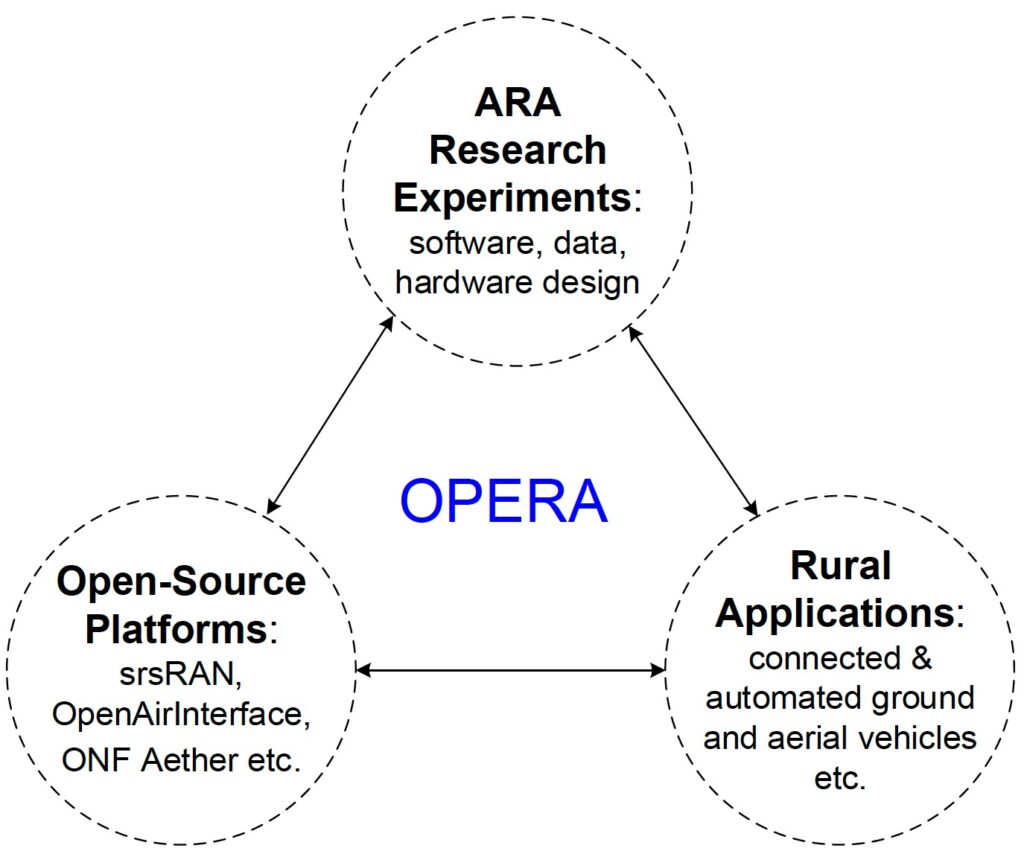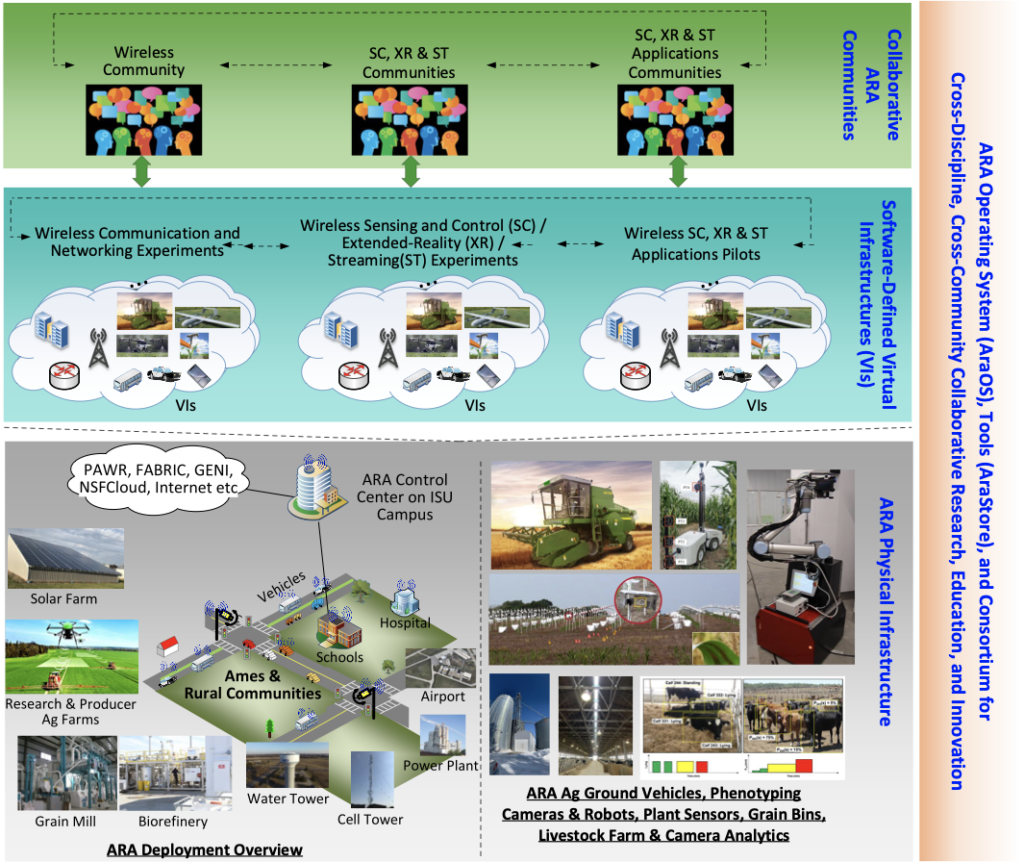AI-Ready Cyber-Agricultural Systems Testbed (AI-AgARENA)
The AI-AgARENA project will develop a national-scale planning roadmap for an artificial intelligence (AI)-ready agricultural research testbed. The proposed infrastructure is designed to support the development and testing of advanced AI technologies in real-world farming environments, enabling breakthroughs in resilient agriculture. The project will unify geographically distributed testbeds across Iowa, Arizona, and Ohio, allowing researchers to evaluate AI methods across a range of crops, soil types, and climatic conditions. By integrating autonomous robotics, wireless networking, and multimodal sensing with cyberinfrastructure, AI-AgARENA aims to democratize access to agricultural data and test environments for a broad research community. The project addresses pressing challenges in food security and agricultural resilience while supporting U.S. leadership in emerging AI and wireless technologies. The testbed will be designed to support high-throughput multimodal data collection, AI model training and inference, secure and reproducible experimentation, and shared access for academic, industry, and agency partners. The planning effort will engage scientists, educators, industry stakeholders, and government agencies to ensure the testbed is extensible, and responsive to national priorities. Education, outreach, and workforce development are integral to this effort, with special attention to training future AI-agriculture innovators. This project is part of the NSF AI Testbeds program.
ArMORED: Architecture for Massive-MIMO Open RAN Energy-efficient Devices
In collaboration with Skylark Wireless and other industry partners, this project will integrate and scale a wholly new software-defined radio transceiver architecture within a 5G new radio massive multiple input, multiple output system. This is part of the NTIA Innovation Fund NOFO2 program.
Acceleration of Compatibility and Commercialization for Open RAN Deployments (ACCoRD)
A consortium of U.S. carriers (AT&T, Verizon), consulting foreign carriers (NTT DOCOMO, Reliance Jio), and American OTICs (e.g., ARA OTIC) will establish a testing, evaluation, and R&D center focus on testing network performance, interoperability, and security, and facilitate research into new testing methods. This is part of the NTIA Innovation Fund NOFO1 program.
Real-Time Liquid Wireless Networking for Data-Intensive Rural Applications
Rural broadband is a foundation for a strong rural economy and quality of life, and many rural applications require real-time data-intensive communications. Wireless networks are essential building blocks of rural broadband; however, rural wireless is subject to environmental factors such as weather, terrain, foliage, and crop types and densities, and rural wireless networks need to provide coverage to much larger areas with less density than urban networks. To support real-time data-intensive rural applications, this project will investigate Real-Time Liquid Wireless Networking (RT-LWN). The RT-LWN framework is expected to become a foundational component of rural broadband solutions, and the enabled real-time data-intensive rural applications such as agriculture automation and immersive online education are expected to have a transformative impact on rural industries and communities. This project will generate first-of-its-kind real-world measurement data and models of rural access and backhaul links, and they will be of broad use by the research and education communities. This project will create exciting opportunities for broadening participation in computing, and it will help enrich undergraduate and graduate research and education as well as K-12 outreach. Project results will be broadly disseminated.
This project is a part of the National Science Foundation CNS Core program.
AraOptical 2.0: MISO Free-Space Optical Communications for Long-Distance, High-Capacity X-Haul Networking
Rural towns are usually tens of miles or even farther away from one another, and many rural towns and agriculture farms are far away from their nearest Internet backbone connection points. Thus high-capacity, long-distance wireless x-haul networks serve as important middle-mile solutions for connecting rural towns and agriculture farms with one another and with the Internet backbone. However, the existing practice has been mostly limited to microwave bands, and these microwave x-haul systems tends to have limited communication capacity. Free-space optical communications (FSOC) have been explored for high-capacity wireless x-haul networks. However, the existing practice in long-distance FSOC has been limited to inter-satellite data transfers, and terrestrial FSOC has been limited to short-distance communications between close-by buildings. To enable FSOC-based long-distance, high-capacity terrestrial x-haul networking, this project will develop robust Multi Input Single Output (MISO) FSOC systems that are expected to become foundational components of rural broadband solutions. The enabled real-time data-intensive rural applications, such as agriculture automation and XR-based rural education, are expected to have transformative impact on rural industries and communities.
This project is a part of the National Science Foundation CNS RAISE program.
OPERA: An Open-Source Ecosystem for Broadband Prairie
Rural broadband is a foundation for a strong rural economy and quality of life, yet 39% of the rural US lacks broadband access, and most agriculture farms are not connected at all. To address the challenge, the project proposes to develop the OPen-source Ecosystem for bRoadband prAirie (OPERA). OPERA will enable researchers to transform their rural broadband research experiments into open-source software, data, and hardware designs that can be integrated with open-source platforms to generate rural-focused broadband solutions. This will enable broadband technology researchers, open-source communities, and rural regions to collaborate in addressing the rural broadband challenge. Accordingly, the project is expected to not only enable rural-focused broadband technology innovation today but also empower rural regions to become active participants in continuous broadband innovation in the long term.

OPERA is a part of the National Science Foundation Pathways to Enable Open-Source Ecosystems (POSE) program.
ARA-NRDZ Radio Dynamic Zone
Rural America poses unique needs and opportunities for wireless spectrum sharing. On one hand, addressing the rural broadband challenge calls for spectrum accessibility that would be difficult without spectrum sharing. On the other hand, wireless spectrum tends to be less heavily used in rural regions today, and this offers opportunities of experimenting with novel spectrum management strategies for the unused spectrum. In addition, many spectrum users in rural regions tend to be sparsely distributed, and their spectrum use tends to vary over space and time too, offering opportunities for dynamic spectrum sharing. To address the need and to leverage the opportunity for spectrum sharing in rural regions, this project will investigate the ARA-NRDZ radio dynamic zone to enable research, education, innovation, and field testing of a wide range of dynamic spectrum sharing solutions and applications. The enabled spectrum sharing will help improve real-world spectrum use efficiency, reduce spectrum access cost, and empower rural communities to participate in addressing the rural broadband challenge. This project will create exciting opportunities for broadening participation in computing and networking, and it will help enrich undergraduate and graduate research and education as well as K-12 outreach. This project will also integrate the research findings and education materials into the ARA wireless living lab activities which are expected to engage broad stakeholders from industry, communities, government, and academia in advancing the state of the practice in rural broadband and spectrum sharing.
This project is a part of the NSF National Radio Dynamic Zone (NRDZ) program.
ARA: Wireless Living Lab for Smart and Connected Rural Communities
ARA is an at-scale platform for advanced wireless research to be deployed across the Iowa State University (ISU) campus, City of Ames (where ISU resides), and surrounding research and producer farms as well as rural communities in central Iowa, spanning a rural area with diameter over 60km. It serves as a wireless living lab for smart and connected rural communities, enabling the research and development of rural-focused wireless technologies that provide affordable, high-capacity connectivity to rural communities and industries such as agriculture.

ARA is a part of the National Science Foundation Platforms for Advanced Wireless Research (PAWR) program.
ICICLE: Intelligent Cyberinfrastructure with Computational Learning in the Environment
As a national infrastructure that enables artificial intelligence at the flick of a switch, ICICLE will transform today’s AI landscape from a narrow set of privileged disciplines to one where democratized AI empowers domains broadly through integrated plug-and-play AI. Converging under one virtual roof, ICICLE will foster interdisciplinary communities, advance foundational AI and CI, and transform application domains. Through its innovative approach to training and technology transfer, ICICLE will grow an AI-enabled workforce and incubate innovative companies with sustained diversity and inclusion at all levels. Ultimately, ICICLE will enable a transparent and trustworthy national infrastructure for an AI-enabled future to address pressing societal problems and enable decision-making for national priorities.
ICICLE is a part of the National Science Foundation AI Institutes program.
CyNet: End-to-End Software-Defined Cyberinfrastruture for Smart Agriculture and Transportation
Image processing- and other sensor-based understanding of plant behavior are becoming key to the new discoveries in plant genotypes leading to a more productive and environment-friendly farming. Similarly, connectivity and autonomy are two main drivers of a safe, efficient, and sustainable transportation vision, and real-world study of connected and automated vehicles (CAVs) is a key tool towards realizing that vision. Existing research and education in agriculture and transportation systems are constrained by the lack of connectivity between field-deployed equipment and cloud infrastructures. To fulfill this gap, we will establish the CyNet cyberinfrastructure at Iowa State University (ISU). CyNet features advanced, field-deployed wireless networks with open-source hardware and software platforms, 10Gbps software-defined optical networks, high-performance cloud computing infrastructures, as well as infrastructure virtualization and management systems that transform the CyNet hardware platforms into a software-defined, shared-use infrastructure.
CyNet is expected to stimulate research and field deployment of PRRT wireless networks (e.g., those considered in 5G and beyond). CyNet is also expected to enable transformative plant science studies and farming practice which promise to move agriculture into a new era in which inputs are optimized, farmer profitability is increased, production levels are less variable from year to year, and the ecological foot-print of agriculture is minimized. CyNet will also enable transformative research in connected and automated transportation, which is key to transportation safety, efficiency, and sustainability. CyNet will enable exciting interdisciplinary education activities in networking, computing, agriculture, and transportation, and it will help engage under-represented students in STEM education.